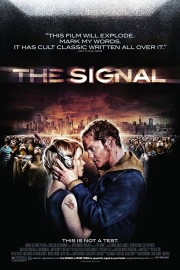The Signal
The Atlanta-made horror film “The Signal” combines the apocalyptic vision of Romero’s “Dead” saga, the psychological terror of “The Shining,” the visceral gore of “Evil Dead,” all within a structure that reminds one of “Pulp Fiction,” but allows for the dark humor of “Evil Dead 2” and the psychological quest for identity of “Memento.” That’s a lot of varying elements, but there’s a strong vision to the film shared by co-writers/directors David Bruckner, Jacob Gentry and Dan Bush that makes it all feel wholly original nonetheless. This is how you do horror folks.
The basic story is simple enough: it starts with a love triangle revolving around Miya (Anessa Ramsey), the young wife of Lewis (AJ Bowen, a fellow Lassiter High School alum and our Band president our senior year), and her lover Ben (Justin Welborn) within the modern city of Terminus. It’s New Year’s Eve, and things are restless for Mya and Ben; they clearly love each other- Ben gives her a mix CD and wants to take her away from her husband, who she’s clearly ambivalent about- but Mya is conflicted.
That will turn out to be the least of their problems. A mysterious signal starts coming from TVs, radios, and phones (think “The Ring,” or Japan’s “Ringu” if you so prefer). The next thing you know, it’s a return to the primal instincts of man, and it’s survival of the fittest for all involved. Lewis goes off the deep end with a friend who won’t stop swinging his bat around. A man takes hedge trimmers to a woman’s jugular. A friend makes a mace out of knives for protection from the crazies around him, although he’s not above letting the signal grab a hold of him as well. Terminal 13 and escape from Terminus provides a refuge for Mya and Ben, much like Shell Beach did for the protagonists of “Dark City.”
Few horror films dare to be so formally inventive; though the film follows a very clear three-act structure, each act provides a different perspective and slant on the events occurring. Bruckner, Gentry, and Bush take a unique approach to the anthology nature as well- each one directs a different section, befitting their personal sensibilities, with the others serving as editor, writer, and camera operator for the one in charge, providing a sense of continuity to the whole, maintaining the same tone and rhythms of storytelling throughout (Ben Lovett’s evocative score provides further continuity). Thinking back on it, I was reminded of an idea my friend Chris had for a short film series he was looking to do, where he’d have different directors take on different chapters of the same story, but with their own sensibilities coming through. It’s unlikely to happen the way things are going, but this film is a good example as to how that type of idea could work with the right artistic vision.
Transmission I (“Love is Crazy”) follows Mya from Ben’s apartment to the one she shares with Lewis, and is our entry into the insanity to follow. The mood here is unsettling in the vein of “The Shining” and other similarly visceral horror films (especially recent Japanese horror films), and we sense the danger of the situation immediately, and follow Mya as she tries to escape from it as best she can, even if that means leaving Lewis tied up in their apartment after he’s killed his friend. The prelude to this section- a scene in bed between Mya and Ben- provides the emotional connection we need with these characters to continue with them through the remainder of the film.
Transmission II (“The Jealousy Monster”) follows Lewis as he escapes from his trappings and hunts for Mya, leading him to an apartment where a buxom wife is getting ready to host a New Year’s Eve party even as her husband sits dead by her own hand. The overall tone here is gallows humor, all perfectly timed as it was in “Shaun of the Dead,” and a showcase for Bowen, who maintains Lewis’ unnerving mood as the film’s villain while laying in well-modulated moments of dark comedy. For some, the film will jump the shark too much into camp, but I enjoyed the audacity the filmmakers showed the run all the way with it without losing the tension.
Transmission III (“Escape From Terminus”) is the most problematic section of the film. Here we follow Ben from his encounter with Lewis to when he finally reunites with Mya. It’s the most conventional section of the movie, and though the actors sell it, it lacks the overall intrigue of the previous sections because of how, shall I say?, oblique it feels in tone. It doesn’t really find the right notes, and though it leads to a fascinating and satisfying conclusion, it feels like the filmmakers started to run out of ideas. No matter; I’ve seen bigger horror films that didn’t even try to do anything this original, or worked so well at doing what it did.










